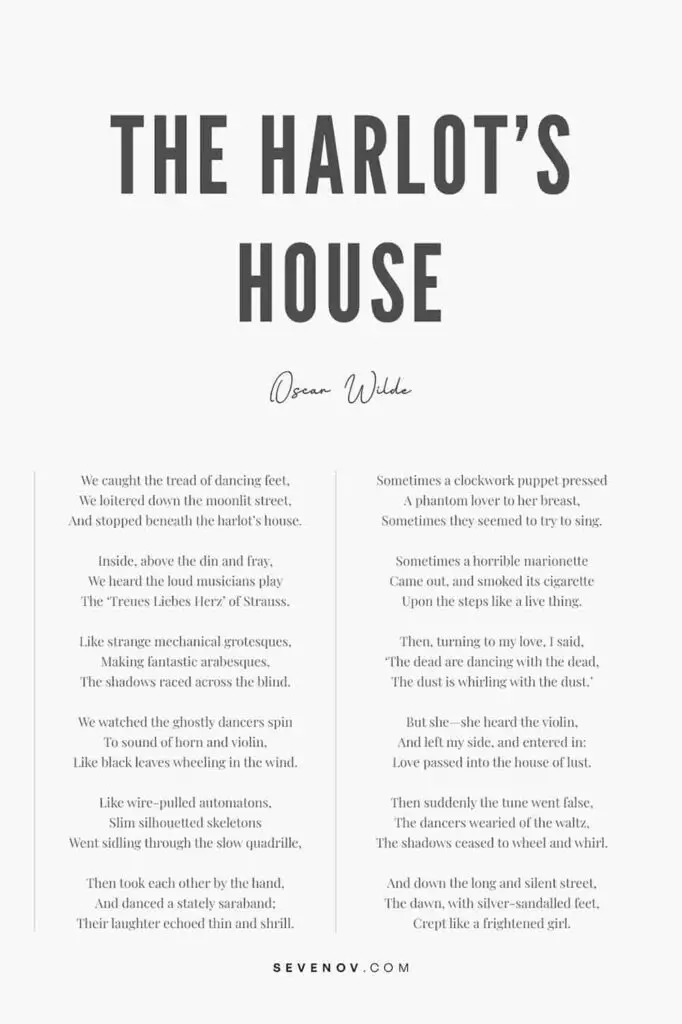
The Harlot’s House by Oscar Wilde
“The Harlot’s House” by wit, dramatist, and poet Oscar Wilde is a hauntingly vivid poem that delves into the themes of love, temptation, and the macabre. Set against a nocturnal backdrop, the poem narrates an encounter with a house of ill-repute. Wilde masterfully weaves a tapestry of eerie and surreal imagery to depict the scene, using metaphors and similes that bring the uncanny atmosphere of the harlot’s house to life. The dancers inside the house are likened to ghostly figures, automatons, and marionettes, creating a sense of the unnatural and the grotesque.
“The Harlot’s House” is included in Oscar Wilde’s Poems, a poetry collection that displays Wilde’s range and depth as a poet. Those interested in exploring more of Wilde’s poetic works can find the Poems online book at PageVio.
1. The Poem
We caught the tread of dancing feet,
We loitered down the moonlit street,
And stopped beneath the harlot’s house.
Inside, above the din and fray,
We heard the loud musicians play
The ‘Treues Liebes Herz’ of Strauss.
Like strange mechanical grotesques,
Making fantastic arabesques,
The shadows raced across the blind.
We watched the ghostly dancers spin
To sound of horn and violin,
Like black leaves wheeling in the wind.
Like wire-pulled automatons,
Slim silhouetted skeletons
Went sidling through the slow quadrille,
Then took each other by the hand,
And danced a stately saraband;
Their laughter echoed thin and shrill.
Sometimes a clockwork puppet pressed
A phantom lover to her breast,
Sometimes they seemed to try to sing.
Sometimes a horrible marionette
Came out, and smoked its cigarette
Upon the steps like a live thing.
Then, turning to my love, I said,
‘The dead are dancing with the dead,
The dust is whirling with the dust.’
But she—she heard the violin,
And left my side, and entered in:
Love passed into the house of lust.
Then suddenly the tune went false,
The dancers wearied of the waltz,
The shadows ceased to wheel and whirl.
And down the long and silent street,
The dawn, with silver-sandalled feet,
Crept like a frightened girl.

Download The Harlot’s House Poster
Size: 8″ x 12″ (2:3 ratio)
Format: PDF
Copyright information: For personal use only
Note: Actual poster background color is white. For the sample poster, the background is made gray for illustration purpose.
2. The Harlot’s House Analysis
“The Harlot’s House” narrates a haunting and evocative scene that blends the allure of a nocturnal urban landscape with macabre and surreal imagery. Here’s a detailed breakdown:
Opening Scene
“We caught the tread of dancing feet, / We loitered down the moonlit street, / And stopped beneath the harlot’s house.” – The poem begins with the speaker and his companion drawn by the sound of dancing to a house of ill repute, setting a tone of intrigue and nocturnal mystery.
Inside the House
“Inside, above the din and fray, / We heard the loud musicians play / The ‘Treues Liebes Herz’ of Strauss.” – Inside the house, a Strauss piece, likely symbolizing a romantic or passionate atmosphere, contrasts with the scene’s otherwise dark setting.
“Like strange mechanical grotesques, / Making fantastic arabesques, / The shadows raced across the blind.” – The description of shadows and mechanical movements gives a surreal, almost nightmarish quality to the scene, suggesting a dance that’s both enticing and unsettling.
Dance of the Dead
“We watched the ghostly dancers spin / To sound of horn and violin, / Like black leaves wheeling in the wind.” – The dancers are compared to leaves in the wind, emphasizing their ephemeral and ghostly nature.
“Like wire-pulled automatons, / Slim silhouetted skeletons / Went sidling through the slow quadrille,” – The dancers are likened to skeletons and automatons, evoking a sense of the macabre and the unnatural.
Surreal and Macabre Imagery
“Then took each other by the hand, / And danced a stately saraband; / Their laughter echoed thin and shrill.” – The dance becomes more formal, but the laughter remains eerie and unsettling.
“Sometimes a clockwork puppet pressed / A phantom lover to her breast, / Sometimes they seemed to try to sing.” – The imagery here blurs the line between the living and the mechanical, enhancing the surreal quality of the scene.
The Marionette
“Sometimes a horrible marionette / Came out, and smoked its cigarette / Upon the steps like a live thing.” – This vivid image of a marionette smoking blurs reality and artifice, adding to the poem’s eerie atmosphere.
The Turn
“Then, turning to my love, I said, / ‘The dead are dancing with the dead, / The dust is whirling with the dust.’” – The speaker realizes the lifelessness and decay inherent in the scene.
“But she—she heard the violin, / And left my side, and entered in: / Love passed into the house of lust.” – The companion is drawn into the house, symbolizing the seductive power of base desires over genuine love.
Conclusion
“Then suddenly the tune went false, / The dancers wearied of the waltz, / The shadows ceased to wheel and whirl.” – The music becomes discordant, signaling an end to the dance and the disillusionment of the scene.
“And down the long and silent street, / The dawn, with silver-sandalled feet, / Crept like a frightened girl.” – The poem ends with the arrival of dawn, personified as a frightened girl, suggesting innocence or purity witnessing the aftermath of the night’s debauchery.
Overall, the poem is rich in symbolism and imagery, contrasting the allure of the night and its temptations with the stark reality of daybreak. It explores themes of desire, the ephemeral nature of pleasure, and the thin line between life and the macabre.
3. Conclusion
If “The Harlot’s House” has sent shivers down your spine, you might enjoy exploring more of Oscar Wilde’s poetic works.




